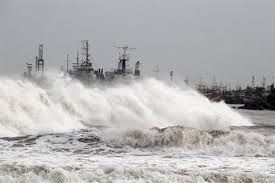
'Phailin', a very severe cyclonic storm, said to be the second strongest after the disastrous super-cyclone of 1999, today struck the Odisha coast, bringing in its wake torrential rains and wind speeds of over 200 kmph in the state and in the neighbouring north coastal Andhra Pradesh.
Darkness enveloped wide swathes of the coastal districts of Odisha, especially Ganjam, whose Gopalpur-on-sea was the entry point for the storm uprooting trees and electric poles. People were forced to remain indoors by the pounding rains and vehicular traffic came to a grinding halt.
Heavy to very heavy rainfall were also widespread in the districts of Gajapati, Khurda, Puri, Jagatsinghpur, Nayagarh, Cuttack, Bhadrak and Kendrapara in coastal region besides state capital Bhubaneshwar.
However, the extent of damage wreaked by the cyclone was not immediately available. Three people were killed in Odisha in the heavy rains ahead of the storm.
The cyclone made its landfall "very close to Gopalpur town" around 9 pm and has just started crossing the coast in Odisha, IMD Director General L S Rathore told reporters in New Delhi just a little later.
"Still there is scope the speed to go up as the cyclone will remain very severe for six hours. Post landfall, there will be no large change in the intensity," he said, adding that for another 12 to 24 hours, there will be moderate rains in large parts of east India.
He denied that 'Phailin' was a super cyclone.
Nearly six lakh people were evacuated, including 4.50 lakh in Odisha and over one lakh in Andhra Pradesh.
Army, IAF, Navy, CRPF and National Disaster Response Force were positioned in areas vulnerable to the cyclone.
All trains between Howrah and Visakhapatnam have been suspended and power supply switched off along the Odisha coastline, and three coastal districts in Andhra Pradesh as a precautionary measure.
Flights and trains from Odisha capital Bhubaneshwar have also been suspended.
At least 10 flights of Air India, Indigo and Jet Airways scheduled to arrive or take off from the airport here remained cancelled, director of Biju Patnaik International Airport Sarad Kumar told PTI.
This is the strongest since the one in 1999 that wreaked havoc in Odisha, leaving at least 9,000 people dead.
"Our main focus is to avoid loss of human life. So far we have evacuated 4.50 lakh people in Odisha and 1 lakh more in Andhra Pradesh," Union Home Secretary Anil Goswami earlier told reporters in Delhi.
Most of the evacuated people have been sheltered in 500 specially-built cyclone camps in the two states. Each cyclone shelter can accommodate up to 1,500 people while their ground floors may be used as cattle shelters.
Met officials said the impact of cyclone Phailin would be highest during the night and gradually come down from dawn. Reports said that two more people were killed in Odisha when trees fell on them following strong winds.
The National Disaster Management Authority said it had deployed nearly 2,000 National Disaster Response Force personnel in Andhra Pradesh, Odisha and West Bengal.
Five lakh tonnes of foodgrains has been kept ready for distribution to the people in the affected region.
"We are ready with 5 lakh tonnes of foodgrains for distribution to cyclone-affected people in Andhra Pradesh and Odisha," Union Food Minister K V Thomas said.
Rains also lashed parts of West Bengal, Chhattisgarh, East UP and Bihar.
More than one lakh people in low-lying coastal areas of Srikakulam, Vizianagaram and Visakhapatnam districts in Andhra Pradesh were shifted to safer places.
Srikakulam district, bordering Odisha, started receiving heavy rainfall under the cyclone's impact since morning.
Chief Minister N Kiran Kumar Reddy told reporters after a high-level review meeting in the afternoon that "all possible precautions" have been taken to ensure there was no loss of life due to the cyclone.
"Our preparedness is good. We have taken all precautions required. Beyond that there is nothing we can do," he said.
He said out of 22,994 fishing boats in coastal districts, only 22 remained in sea and have not reached the shore yet. "But we have information that these boats and the fishermen are at a safe place. We are monitoring their movement," he added.
A high alert has been sounded in Srikakulam district in particular as rivers like Vamsadhara, Nagavali and Bahuda could be in spate because of heavy rains.
In West Bengal, disaster management, civil defence and rescue teams have been deputed in Digha, Shankarpur, Contai, Mandarmoni, Diamond Harbour and some areas of the Sundarban.
The MET office predicted heavy to very heavy rains at at some places over East and West Midnapore, North and South 24-Parganas, Howrah, Hooghly, Bankura, Burdwan and Purulia districts in the next 48-hours. Kolkata would experience light to medium rainfall.





Comments
Add new comment